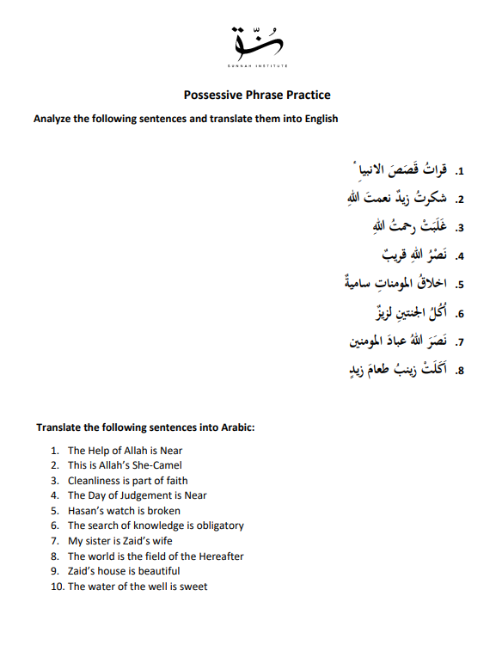QURANIC
ARABIC
Starting July 5, 2025
Days: Saturday & Sunday
Time: 12 PM EST, 9 PM PK, 5 PM UK
Duration: 10 Sessions
Course Fee: USD 20 for 10 Sessions
Quranic Arabic: Level I
Course Description
The course is designed to develop a solid foundation in Qur’anic Arabic by systematically exploring the different types of nouns, verbs, and sentence constructions found in the Qur’anic text. Alongside grammar, students will steadily build a high-frequency vocabulary bank drawn directly from the Qur’an, enabling them to better understand and reflect on its language and meaning.


Course Components:
In-depth grammar instruction rooted in Qur’anic usage
Daily high-frequency Qur’anic vocabulary lists
Exercises and parsing practice using actual verses from the Qur’an
Progress tracking and application through guided reading
Daily Qur’anic vocabulary lists featuring high-frequency words
COURSE
OUTLINE
Introduction to the three fundamental categories of words in Arabic: Ism (noun), Fi‘l (verb), and Harf (particle)—with examples from the Qur'an for each.
Understanding the role and usage of pronouns, their function in sentence structure, and how they appear in the Qur'anic text.
Study of independent pronouns (ḍamā’ir munfaṣilah) and attached pronouns (ḍamā’ir muttaṣilah), with Qur'anic examples to highlight their grammatical behavior and meaning.
Exploration of proper vs. common nouns, definite vs. indefinite forms, and abstract vs. concrete nouns in the Qur'an.
Study of singular, dual, and plural forms—sound plurals and broken plurals—with application to Qur'anic examples.
Identifying feminine nouns, feminine markers (e.g., tāʾ marbūṭah), and their impact on agreement in sentences as seen in the Qur'an.
Overview of verb categories—past, present, and future tense—with focus on their form and function in Qur'anic verses.
Conjugation patterns and meanings of past tense verbs, along with parsing practice using Qur'anic verbs.
Study of verb prefixes and subject agreement, and their usage in expressing ongoing actions in the Qur'an.
Understanding how future tense is conveyed in Arabic using particles like sa- and sawfa, with Qur'anic examples.
Introduction to the two major types: Nominal (ismiyyah) and Verbal (fi‘liyyah) sentences, with structural analysis from the Qur'an.
Learning adjective-noun agreement in gender, number, and definiteness with Qur'anic examples.
Understanding possession in Arabic grammar, and how this structure is used throughout the Qur'an.
Usage of demonstrative pronouns for near objects, and their grammatical agreement.
Usage and rules governing far demonstratives in Qur'anic context.
Structure, subject-predicate agreement, and identifying nominal sentences in the Qur'an.
Recognizing action-based sentences and understanding how subject-verb-object sequences work in the Qur'an.
Identifying the doer and the object in a sentence and understanding how word order affects meaning in the Qur'an.
Common Arabic prepositions, their function, and how they govern the nouns that follow—applied to Qur'anic verses.
Understanding how the passive is formed in the past tense, with examples from the Qur’an where the doer is omitted.
Learning the passive structure in the present/future tenses and its impact on sentence meaning.
Introduction to nouns that indicate time and place, and their usage in Qur'anic descriptions and events.



